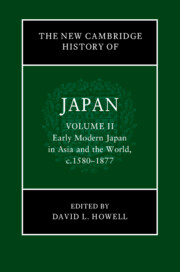Book contents
- The New Cambridge History of Japan
- The New Cambridge History of Japan
- The New Cambridge History of Japan
- Copyright page
- Contents
- Figures
- Maps
- Tables
- Contributors to Volume II
- Preface
- Frontispiece
- Introduction
- Part I The Character of the Early Modern State
- PART II Economy, Environment, and Technology
- Part III Social Practices and Cultures of Early Modern Japan
- 13 Religion in the Tokugawa Period
- 14 The Medical Revolution in Early Modern Japan
- 15 Flows of People and Things in Early Modern Japan
- 16 Labor and Migration in Tokugawa Japan
- 17 The Tokugawa Status Order
- 18 On the Peripheries of the Japanese Archipelago
- 19 The Early Modern City in Japan
- 20 Popular Movements in Early Modern Japan
- 21 Civilization and Enlightenment in Early Meiji Japan
- Index
- References
20 - Popular Movements in Early Modern Japan
Petitions, Riots, Martyrs
from Part III - Social Practices and Cultures of Early Modern Japan
Published online by Cambridge University Press: 15 January 2024
- The New Cambridge History of Japan
- The New Cambridge History of Japan
- The New Cambridge History of Japan
- Copyright page
- Contents
- Figures
- Maps
- Tables
- Contributors to Volume II
- Preface
- Frontispiece
- Introduction
- Part I The Character of the Early Modern State
- PART II Economy, Environment, and Technology
- Part III Social Practices and Cultures of Early Modern Japan
- 13 Religion in the Tokugawa Period
- 14 The Medical Revolution in Early Modern Japan
- 15 Flows of People and Things in Early Modern Japan
- 16 Labor and Migration in Tokugawa Japan
- 17 The Tokugawa Status Order
- 18 On the Peripheries of the Japanese Archipelago
- 19 The Early Modern City in Japan
- 20 Popular Movements in Early Modern Japan
- 21 Civilization and Enlightenment in Early Meiji Japan
- Index
- References
Summary
During the Tokugawa period, commoners developed increasingly sophisticated methods of challenging what they perceived as unjust government policies or unethical behavior by the wealthy. Popular movements coalesced around petitions that stated grievances. They typically took the form of mass demonstrations that required preparation, organization, and leadership. Even urban food riots had a logic to them. In many cases, they erupted after women had called on merchants to feed the poor, and they followed a code for conduct that cautioned against stealing. In the early nineteenth century, farmers created village leagues that employed representatives to manage issues with regional implications and make their case for commercial policies. In some instances, they argued that all human beings are equal, an argument made unsuccessfully by outcaste villagers. Villagers commemorated popular movements in chronicles and tales, mixing fact and fiction in the interests of a good story, and they remembered their fallen leaders in memorial services.
Keywords
- Type
- Chapter
- Information
- The New Cambridge History of Japan , pp. 659 - 688Publisher: Cambridge University PressPrint publication year: 2023



